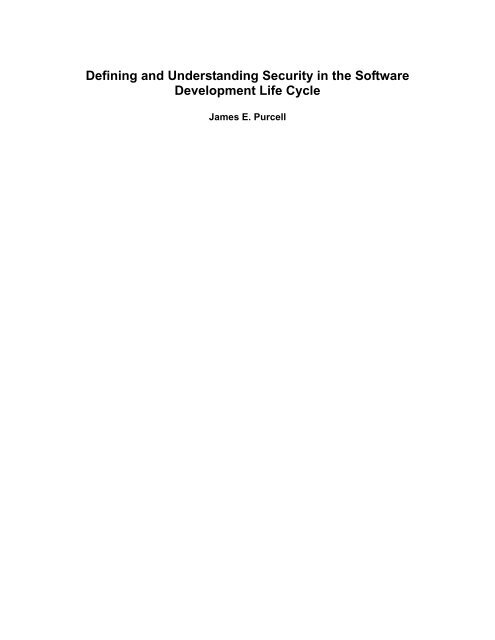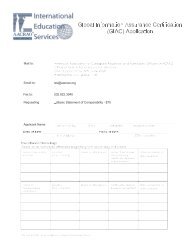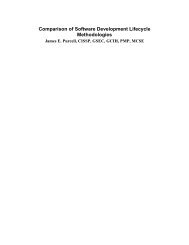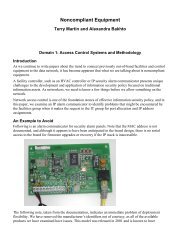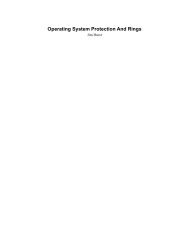Defining and Understanding Security in the Software ... - GIAC
Defining and Understanding Security in the Software ... - GIAC
Defining and Understanding Security in the Software ... - GIAC
You also want an ePaper? Increase the reach of your titles
YUMPU automatically turns print PDFs into web optimized ePapers that Google loves.
<strong>Def<strong>in</strong><strong>in</strong>g</strong> <strong>and</strong> Underst<strong>and</strong><strong>in</strong>g <strong>Security</strong> <strong>in</strong> <strong>the</strong> <strong>Software</strong><br />
Development Life Cycle<br />
James E. Purcell
<strong>Def<strong>in</strong><strong>in</strong>g</strong> <strong>and</strong> Underst<strong>and</strong><strong>in</strong>g <strong>Security</strong> <strong>in</strong> <strong>the</strong> <strong>Software</strong> Development<br />
Life Cycle<br />
Introduction<br />
The purpose of this paper is to help you underst<strong>and</strong> <strong>the</strong> important role that security plays<br />
<strong>in</strong> <strong>the</strong> <strong>Software</strong> Development Life Cycle (SDLC). The paper def<strong>in</strong>es security as it applies<br />
to <strong>the</strong> SDLC <strong>and</strong> discusses overall SDLC security issues. It <strong>the</strong>n covers each phase of <strong>the</strong><br />
SDLC <strong>and</strong> specific security controls <strong>and</strong> issues for each phase. After discuss<strong>in</strong>g <strong>the</strong><br />
SDLC, we apply its uses to a fictitious company to illustrate <strong>the</strong> concepts.<br />
Note that <strong>the</strong> SDLC acronym is also used to represent System Development Life Cycle.<br />
In many cases, a decision is made to purchase or outsource <strong>the</strong> software <strong>and</strong> associated<br />
hardware <strong>and</strong> network systems needed to implement a new application. This is often<br />
referred to as <strong>the</strong> “buy or build” decision. Buy means you will purchase a f<strong>in</strong>ished<br />
product from a vendor <strong>and</strong> build means you will hire someone to develop it for you. This<br />
paper focuses on <strong>the</strong> <strong>Software</strong> Development Life Cycle, but most of <strong>the</strong> phases, terms,<br />
<strong>and</strong> issues discussed apply to both <strong>the</strong> “buy” <strong>and</strong> “build” process.<br />
Def<strong>in</strong>ition of <strong>Security</strong> <strong>in</strong> <strong>the</strong> SDLC<br />
When def<strong>in</strong><strong>in</strong>g security <strong>in</strong> <strong>the</strong> SDLC, two areas must be addressed. The first area is <strong>the</strong><br />
SDLC process itself. The second area is application operational security. You must<br />
underst<strong>and</strong> <strong>the</strong> SDLC process <strong>and</strong> associated security activities <strong>and</strong> <strong>the</strong> specific<br />
application <strong>and</strong> operational security controls that are available to <strong>the</strong> application designer.<br />
<strong>Security</strong> <strong>in</strong> <strong>the</strong> SDLC Process<br />
The SDLC process consists of six phases (discussed <strong>in</strong> detail later). In each phase,<br />
specific security related activities take place to ensure that security is built <strong>in</strong>to <strong>the</strong><br />
software system under development. For example, <strong>in</strong> one phase, SDLC Project Initiation<br />
Phase, a security related activity is to def<strong>in</strong>e <strong>the</strong> sensitivity of <strong>the</strong> <strong>in</strong>formation that <strong>the</strong><br />
software system will process. By plac<strong>in</strong>g this security related activity early <strong>in</strong> <strong>the</strong> SDLC<br />
process, later decisions are made based on <strong>the</strong> security needs of <strong>the</strong> organization <strong>and</strong> not<br />
as an afterthought.<br />
Application Operational <strong>Security</strong><br />
As <strong>the</strong> development team moves through <strong>the</strong> phases of <strong>the</strong> SDLC, decisions are made to<br />
add security controls to <strong>the</strong> application to ensure <strong>the</strong> proper protections to confidentiality,<br />
<strong>in</strong>tegrity, <strong>and</strong> availability. These application <strong>and</strong> operational controls can be<br />
adm<strong>in</strong>istrative controls, physical controls, or technical controls. An example of an<br />
adm<strong>in</strong>istrative control designed <strong>in</strong>to <strong>the</strong> application <strong>in</strong> <strong>the</strong> Operations <strong>and</strong> Ma<strong>in</strong>tenance<br />
Phase is Separation of Duties. In each SDLC phase, example applications controls that<br />
are appropriate for <strong>the</strong> phase are def<strong>in</strong>ed <strong>and</strong> discussed.
SDLC <strong>Security</strong> Issues<br />
The goal of a good SDLC process is to capture, verify, <strong>and</strong> implement all <strong>the</strong><br />
requirements needed to make <strong>the</strong> application useful to <strong>the</strong> organization. These<br />
requirements <strong>in</strong>clude security needs def<strong>in</strong>ed around confidentiality, <strong>in</strong>tegrity, <strong>and</strong><br />
availability of <strong>the</strong> <strong>in</strong>formation system. If security requirements are correctly identified<br />
<strong>and</strong> <strong>the</strong> proper security controls added are to <strong>the</strong> application to meet <strong>the</strong>se requirements,<br />
<strong>the</strong> result is a secure application. But <strong>in</strong> reality, develop<strong>in</strong>g applications <strong>in</strong>volves tradeoffs<br />
to meet budget, resource, <strong>and</strong> time constra<strong>in</strong>ts placed on <strong>the</strong> project. In many cases,<br />
security is <strong>the</strong> first requirement to be dropped.<br />
Ano<strong>the</strong>r security SDLC issue is <strong>the</strong> lack of security tra<strong>in</strong><strong>in</strong>g <strong>and</strong> knowledge among<br />
developers <strong>and</strong> system designers. Poor design decisions are made when developers are<br />
not aware of current security risks. As a result of <strong>the</strong>se SDLC security short com<strong>in</strong>gs,<br />
security is often an afterthought, <strong>and</strong> security controls are implemented as add-ons after<br />
<strong>the</strong> project is complete <strong>and</strong> security issues come to light. Applications built this way<br />
become overly complex, expensive, <strong>and</strong> hard to ma<strong>in</strong>ta<strong>in</strong>. This ensures that security is<br />
fur<strong>the</strong>r compromised <strong>and</strong> <strong>the</strong> application system suffers from cont<strong>in</strong>ued security<br />
problems.<br />
Even if a system is designed <strong>and</strong> developed with security <strong>in</strong> m<strong>in</strong>d, systems change over<br />
time. New equipment, software, <strong>and</strong> functionality are added to systems regularly over<br />
time. These changes must be authorized <strong>and</strong> tracked, <strong>and</strong> security issues need to be<br />
evaluated as part of a configuration management process.<br />
The rest of <strong>the</strong> paper describes how to build <strong>in</strong> security at each phase of <strong>the</strong> SDLC <strong>and</strong><br />
discusses typical controls at <strong>the</strong> disposal of <strong>the</strong> system designer to guard <strong>the</strong><br />
confidentiality, <strong>in</strong>tegrity, <strong>and</strong> availability of <strong>the</strong> application. The example application<br />
described is a customer <strong>in</strong>formation system for <strong>GIAC</strong> Bikes. <strong>GIAC</strong> Bikes is a company<br />
that designs <strong>and</strong> sells custom trail bikes at both its retail store <strong>and</strong> over <strong>the</strong><br />
<strong>GIAC</strong>Bikes.com website.<br />
SDLC Phases<br />
Project Initiation<br />
In <strong>the</strong> Project Initiation Phase of <strong>the</strong> SDLC, <strong>GIAC</strong> Bikes determ<strong>in</strong>es <strong>the</strong> need for <strong>the</strong><br />
customer <strong>in</strong>formation system. The bus<strong>in</strong>ess needs <strong>the</strong> system to allow <strong>GIAC</strong> Bikes to<br />
better track customer buy<strong>in</strong>g habits <strong>and</strong> preferences to better plan future bike designs <strong>and</strong><br />
market<strong>in</strong>g plans. If no bus<strong>in</strong>ess case for <strong>the</strong> system can be made, this is <strong>the</strong> time to drop<br />
<strong>the</strong> system project before any more time or money is spent.<br />
The security activity that <strong>the</strong> <strong>GIAC</strong> Bikes system development team performs <strong>in</strong> this<br />
phase is a prelim<strong>in</strong>ary risk assessment. The design team looks at several risk areas,<br />
<strong>in</strong>clud<strong>in</strong>g sensitivity of <strong>in</strong>formation collected, criticality of <strong>the</strong> system to <strong>GIAC</strong> Bikes,<br />
security risks <strong>in</strong> common to customer <strong>in</strong>formation systems, <strong>and</strong> regulatory, legal, <strong>and</strong><br />
privacy issues pert<strong>in</strong>ent to customer <strong>in</strong>formation systems. The system design team<br />
assigns high, medium, <strong>and</strong> low risk values to each area of risk. For <strong>in</strong>stance, because
<strong>GIAC</strong> Bikes does bus<strong>in</strong>ess <strong>in</strong> Europe (where privacy laws are strong) <strong>and</strong> <strong>the</strong> customer<br />
<strong>in</strong>formation system collects personal data, risk <strong>and</strong> impact of <strong>the</strong> confidentiality of <strong>the</strong><br />
system <strong>in</strong>formation is high. In ano<strong>the</strong>r example, although <strong>the</strong> customer <strong>in</strong>formation<br />
system is important to <strong>GIAC</strong> Bikes, bus<strong>in</strong>ess can cont<strong>in</strong>ue if <strong>the</strong> system became<br />
unavailable for a long period of time. Therefore, <strong>the</strong> design team assigns a low risk value<br />
for system availability. Do<strong>in</strong>g <strong>the</strong> prelim<strong>in</strong>ary risk assessment to establish <strong>the</strong> need for<br />
<strong>the</strong> system helps identity any security show stoppers before too much time <strong>and</strong> effort<br />
goes <strong>in</strong>to <strong>the</strong> next SDLC phases. It also gets <strong>the</strong> design team th<strong>in</strong>k<strong>in</strong>g about security<br />
issues early <strong>in</strong> <strong>the</strong> design process.<br />
Design Analysis (Functional Design)<br />
The Design Analysis Phase is where <strong>the</strong> design team th<strong>in</strong>ks about <strong>and</strong> documents specific<br />
functions that <strong>the</strong> system should carry out. For <strong>the</strong> <strong>GIAC</strong> Bikes customer <strong>in</strong>formation<br />
system, some system functions <strong>in</strong>clude collect<strong>in</strong>g customer <strong>in</strong>formation (<strong>in</strong>put), verify<strong>in</strong>g<br />
data <strong>in</strong>tegrity (process<strong>in</strong>g), <strong>and</strong> report<strong>in</strong>g customer preferences (output). An additional<br />
functionality of <strong>the</strong> system is to backup <strong>and</strong> restore <strong>the</strong> customer database.<br />
There are two security activities that take place <strong>in</strong> this phase. The first security activity is<br />
to perform a more detailed risk assessment for each major system function <strong>and</strong> for <strong>the</strong><br />
overall system. Based on this detailed risk assessment, security controls are selected to<br />
mitigate <strong>the</strong> risks identified. For example, because <strong>the</strong>re is a high risk that backup media<br />
can be lost or stolen, <strong>the</strong> design team specifies that encryption is applied to <strong>the</strong> backup<br />
media to mitigate this risk. Encryption is an example of a control that can reduce risk. For<br />
a comprehensive list of adm<strong>in</strong>istrative, technical, <strong>and</strong> physical controls that can be<br />
applied to an <strong>in</strong>formation system, see <strong>the</strong> NIST Special Publication 800-53,<br />
“Recommended <strong>Security</strong> Controls for Federal Information Systems”. Now <strong>the</strong> design<br />
team has <strong>the</strong> functional requirements for <strong>the</strong> <strong>GIAC</strong> Bikes customer <strong>in</strong>formation system<br />
<strong>and</strong> for each functional requirement a level of associated risk <strong>and</strong> possible security<br />
controls to reduce (or mitigate) that risk.<br />
System Design Specifications<br />
In <strong>the</strong> System Design Specification phase, <strong>the</strong> Functional Design from <strong>the</strong> Design<br />
Analysis Phase is translated <strong>in</strong>to detailed specifications. For <strong>in</strong>stance, <strong>the</strong> functional need<br />
for stor<strong>in</strong>g customer <strong>in</strong>formation for <strong>the</strong> <strong>GIAC</strong> Bikes customer <strong>in</strong>formation system is<br />
turned <strong>in</strong>to a database schema. The functional need to have customer reports is translated<br />
<strong>in</strong>to report layouts.<br />
The security activities associated with phase are to design <strong>the</strong> actual security controls<br />
specified <strong>in</strong> <strong>the</strong> Functional Design. For <strong>in</strong>stance, <strong>the</strong> actual method <strong>and</strong> algorithm for<br />
encrypt<strong>in</strong>g <strong>the</strong> backup media is specified. Ano<strong>the</strong>r security activity <strong>in</strong> this phase is to<br />
review <strong>the</strong> completed design specification for any new security issues that have surfaced<br />
dur<strong>in</strong>g detail design. An example here is that <strong>the</strong> <strong>GIAC</strong> design team chooses Oracle as<br />
<strong>the</strong> DBMS system for <strong>the</strong> customer <strong>in</strong>formation system <strong>and</strong> new security controls are<br />
specified because of known weaknesses <strong>in</strong> Oracle database security. At this po<strong>in</strong>t <strong>in</strong> <strong>the</strong><br />
SDLC, <strong>the</strong> <strong>GIAC</strong> Bikes customer <strong>in</strong>formation system design team has designed security<br />
<strong>in</strong>to <strong>the</strong> system based on a risk assessment of threats aga<strong>in</strong>st <strong>the</strong> confidentiality, <strong>in</strong>tegrity,
<strong>and</strong> availability needs of <strong>GIAC</strong> Bikes.<br />
The System Design phase is <strong>the</strong> SDLC phase where most application security controls<br />
are specified. Application controls are applied across <strong>in</strong>put processes, <strong>in</strong>formation<br />
process<strong>in</strong>g processes, <strong>and</strong> output processes. Examples for <strong>the</strong> <strong>GIAC</strong> Bikes customer<br />
<strong>in</strong>formation system <strong>in</strong>clude:<br />
• Input—Test<strong>in</strong>g all <strong>in</strong>put values for correct syntax <strong>and</strong> data ranges<br />
• Process<strong>in</strong>g—Transactions are logged <strong>and</strong> checked for referential <strong>in</strong>tegrity<br />
• Output—Access to data output screens <strong>and</strong> reports are allowed only to<br />
authorized uses with an access control system<br />
Programm<strong>in</strong>g <strong>and</strong> Test<strong>in</strong>g<br />
With <strong>the</strong> design specifications <strong>in</strong> h<strong>and</strong>, <strong>the</strong> focus of <strong>the</strong> SDLC moves to <strong>the</strong> programmers.<br />
Programmers take <strong>the</strong> detailed design specifications <strong>and</strong> beg<strong>in</strong> to translate <strong>the</strong>m <strong>in</strong>to<br />
program code.<br />
<strong>Security</strong> activities that take place <strong>in</strong> this phase <strong>in</strong>clude audit<strong>in</strong>g <strong>the</strong> programs code to<br />
ensure that secure programm<strong>in</strong>g practices are implemented. In addition, programmers<br />
must test <strong>the</strong> code to ensure security controls work as designed. Note that although<br />
programmers perform unit test<strong>in</strong>g on <strong>the</strong>ir own code, separation of duties dictates that <strong>the</strong><br />
system test be performed by a group o<strong>the</strong>r than <strong>the</strong> programmers. System test<strong>in</strong>g is<br />
usually <strong>the</strong> job of <strong>the</strong> QA function. <strong>GIAC</strong> Bikes programmers code <strong>and</strong> test <strong>in</strong>dividual<br />
system modules (<strong>in</strong>put screens, database process<strong>in</strong>g, report programs) <strong>and</strong> <strong>the</strong> <strong>GIAC</strong><br />
Bikes QA team performs a system test of all <strong>the</strong> modules. However, both <strong>the</strong><br />
programmers <strong>in</strong> <strong>the</strong> unit <strong>and</strong> QA <strong>in</strong> <strong>the</strong> system test one major area: They both perform<br />
tests to make sure that all system <strong>in</strong>put is validated. For example, if a user attempts to<br />
<strong>in</strong>ject raw SQL comm<strong>and</strong>s <strong>in</strong>to an <strong>in</strong>put field to return all customer <strong>in</strong>formation, <strong>the</strong><br />
system should detect <strong>and</strong> block <strong>the</strong> attempt.<br />
The goal of unit <strong>and</strong> system test<strong>in</strong>g is to certify <strong>the</strong> system meets <strong>the</strong> design requirements<br />
set forth <strong>in</strong> <strong>the</strong> earlier SDLC phases. <strong>Security</strong> functions are tested to ensure <strong>the</strong>y provide<br />
<strong>the</strong> needed level of protection. For <strong>GIAC</strong> Bikes, <strong>the</strong> encryption method for <strong>the</strong> backup<br />
media is tested to make sure <strong>the</strong> encryption is not easily defeated <strong>and</strong> that <strong>the</strong> backup data<br />
can be restored accord<strong>in</strong>g to <strong>the</strong> documented procedure. Any security shortcom<strong>in</strong>gs are<br />
also documented <strong>in</strong> <strong>the</strong> certification process.<br />
Installation <strong>and</strong> Ma<strong>in</strong>tenance<br />
In <strong>the</strong> Installation <strong>and</strong> Ma<strong>in</strong>tenance phase <strong>the</strong> system is fielded <strong>and</strong> enters <strong>the</strong> operation<br />
<strong>and</strong> ma<strong>in</strong>tenance (O&M) stage.<br />
However, before <strong>the</strong> system is made, operational management signs off on (or accredits)<br />
<strong>the</strong> system. Management makes <strong>the</strong> accreditation decision based on <strong>the</strong> certification<br />
report from <strong>the</strong> Programm<strong>in</strong>g <strong>and</strong> Test<strong>in</strong>g phase. For <strong>GIAC</strong> Bikes, management looks at<br />
<strong>the</strong> test<strong>in</strong>g results of all <strong>the</strong> security controls <strong>and</strong> decides that <strong>the</strong> risks of runn<strong>in</strong>g <strong>the</strong><br />
system have been properly addressed. Based on that decision, <strong>the</strong> system goes <strong>in</strong>to
production mode.<br />
Because no system stays <strong>the</strong> same for long, an important security element <strong>in</strong> this phase is<br />
configuration <strong>and</strong> change management. As changes to <strong>the</strong> system are proposed <strong>and</strong><br />
implemented, <strong>the</strong> changes must be carefully analyzed for security impacts. For example,<br />
<strong>the</strong> <strong>GIAC</strong> Bikes customer <strong>in</strong>formation system is so successful that <strong>GIAC</strong> Bikes bus<strong>in</strong>ess<br />
doubles with<strong>in</strong> a year. To h<strong>and</strong>le <strong>the</strong> <strong>in</strong>creased database process<strong>in</strong>g needs, it is proposed<br />
to upgrade to a newer version of <strong>the</strong> database software <strong>and</strong> <strong>in</strong>crease <strong>the</strong> capacity of <strong>the</strong><br />
database server hardware. As a part if its change control process, <strong>GIAC</strong> Bikes customer<br />
<strong>in</strong>formation system development team analyzes any issues that affect <strong>the</strong> confidentiality,<br />
<strong>in</strong>tegrity, or availability of <strong>the</strong> system dur<strong>in</strong>g <strong>the</strong> upgrade.<br />
The Installation <strong>and</strong> Ma<strong>in</strong>tenance Phase is ano<strong>the</strong>r SDLC phase where application <strong>and</strong><br />
operational controls are important. Two example application operational controls<br />
important to <strong>GIAC</strong> Bikes are accountability controls <strong>and</strong> separation of duties controls. To<br />
implement accountability of <strong>the</strong> <strong>GIAC</strong> Bikes customer <strong>in</strong>formation system, an access<br />
control systems is used to authorize <strong>and</strong> log all user accesses <strong>and</strong> changes to <strong>the</strong> database.<br />
These logs are exam<strong>in</strong>ed regularly <strong>and</strong> any attempted unauthorized activity is<br />
<strong>in</strong>vestigated. Separation of duties is also implemented with an access control system that<br />
allows levels of system access based on <strong>the</strong> need of <strong>the</strong> user to know <strong>the</strong> customer<br />
<strong>in</strong>formation. For <strong>in</strong>stance, a data entry clerk can enter basic customer <strong>in</strong>formation,<br />
although <strong>the</strong> clerk cannot see <strong>the</strong> customer order history. A product pric<strong>in</strong>g analyst can<br />
see aggregated pric<strong>in</strong>g <strong>in</strong>formation; however, <strong>the</strong> analyst cannot see <strong>in</strong>dividual customer<br />
records.<br />
Destruction<br />
In <strong>the</strong> Destruction phase of <strong>the</strong> SDLC, <strong>the</strong> system is retired <strong>and</strong> replaced with a new<br />
system.<br />
The ma<strong>in</strong> security activity <strong>in</strong> this phase is to ensure that any sensitive <strong>in</strong>formation is<br />
properly h<strong>and</strong>led. The data might need to be securely archived or completely destroyed.<br />
The Destruction phase can also be <strong>in</strong>voked dur<strong>in</strong>g system upgrades. When <strong>GIAC</strong> Bikes<br />
upgrades <strong>the</strong> database server, <strong>the</strong> development team makes sure that <strong>the</strong> disk drives on<br />
<strong>the</strong> old server are properly scrubbed of any sensitive <strong>GIAC</strong> Bikes customer <strong>in</strong>formation<br />
before <strong>the</strong> old server is repurposed or disposed.<br />
Summary<br />
If companies follow <strong>the</strong> SDLC phases <strong>and</strong> <strong>in</strong>corporate <strong>the</strong> appropriate security activities<br />
<strong>in</strong> each phase, systems can be developed <strong>in</strong> a secure manner. If security is not built <strong>in</strong> to<br />
<strong>the</strong> system <strong>in</strong> this manner, <strong>the</strong> security shortcom<strong>in</strong>gs of <strong>the</strong> system will be discovered. IT<br />
auditors might f<strong>in</strong>d <strong>the</strong> problems <strong>and</strong> dictate that costly system changes be implemented.<br />
Or, attackers might f<strong>in</strong>d <strong>the</strong> problems <strong>and</strong> cause damage to company assets <strong>and</strong><br />
reputation. <strong>GIAC</strong> Bikes has followed <strong>the</strong> SDLC phases <strong>and</strong> has considered security<br />
issues at every step. This has allowed <strong>GIAC</strong> Bikes to develop, deploy, <strong>and</strong> ma<strong>in</strong>ta<strong>in</strong> a<br />
successful <strong>and</strong> secure system.


